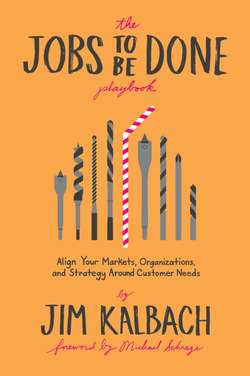Читать книгу The Jobs To Be Done Playbook - Jim Kalbach - Страница 13
На сайте Литреса книга снята с продажи.
CHAPTER 1 Understanding Jobs to Be Done
ОглавлениеIN THIS CHAPTER, YOU WILL LEARN:
• How definitions of JTBD vary
• The origins of JTBD theory and practice
• What divergent schools of thought exist
• The core principles of JTBD
I’ve done a fair number of field interviews over the years—enough that I don’t remember them all. But one stands out that I’ll never forget. It wasn’t what happened during the session that was memorable, but what happened afterward.
I went with the head of marketing for the company where I was consulting to interview a professional in our domain at her workplace. There she was, buried in a pile of folders, with calculators and calendars all around. I focused the discussion not on our product, but on understanding how she worked in general. By all accounts, it was a normal interview, or so I thought.
However, once we left the office building, the marketing person turned to me and said in a dry tone, “Our customers don’t need our product.” For all of the market research he’d done, he never had received that kind of firsthand insight. He hadn’t considered what actually happened on the other end of his offering nor asked people how they thought about their process or needs.
From one single interview, my colleague was already thinking differently. And that was just a start. Imagine what we were able to uncover after a dozen more interviews. It turned out that our offering wasn’t as important to our customers’ needs as we thought. We weren’t in their critical path. The company eventually learned that they had to find new ways to serve customers.
My experience reflects a key challenge: Had our head of marketing not witnessed the customer’s problem firsthand, he wouldn’t have had the same revelation he did about their needs. But not everyone in a company will get that chance. Indeed, most won’t. So how, then, can we consistently translate insights about human needs into actionable intelligence?
Imprecise concepts like desires and emotions are hard to measure and quantify. Seeking to gain empathy, while well intended, lacks a clear beginning or end. It’s no wonder that companies gravitate toward predictable and reliable research on market size and customer demographics. But traditional methods miss important, qualitative insight into why people act as they do.
JTBD provides a way to understand, classify, and organize otherwise irregular feedback. It not only directs you to look at your markets differently, but it also provides a clear and stable unit of analysis: the job. JTBD lets you find the patterns that matter the most, taking the fuzziness out of the fuzzy front end of innovation.
Think of JTBD as an engine of inquiry that informs capabilities across departments—from innovation and strategy to product design and development to marketing and customer support. Having a common aim—understanding the core job and its related emotions and aspirations—is a necessary precursor to having aligned teams and efforts.
